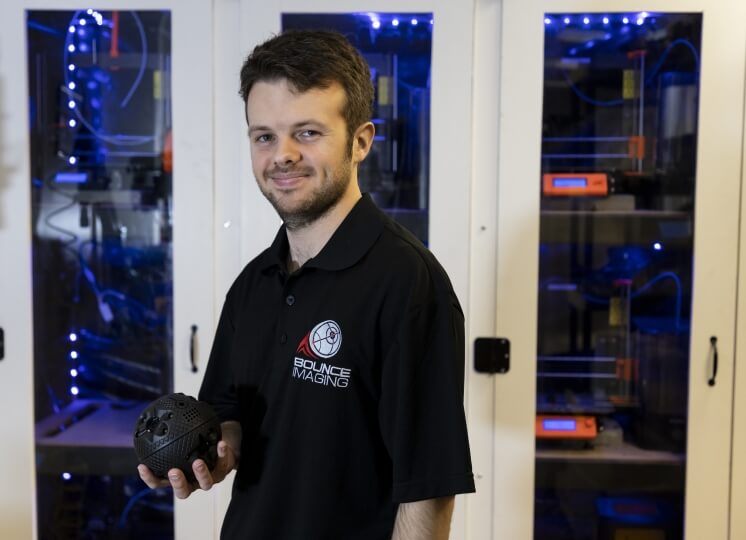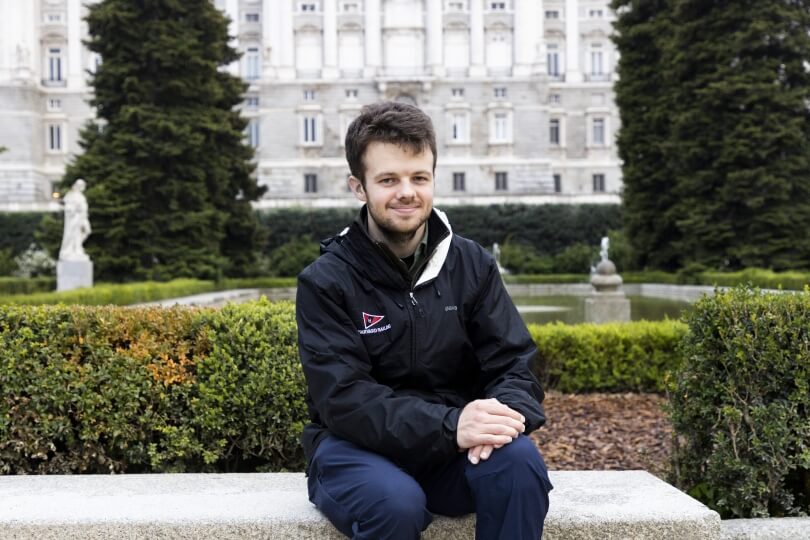Robert Anderson, S.B. '19, is the senior mechanical engineer at Bounce Imaging, designing 360-degree video and audio recording cameras for first-responder and military use.
Firefighters risk their lives whenever they enter a burning building to look for trapped occupants. SWAT units risk their lives when they respond to an armed hostage situation without knowing exactly where the hostage takers are located. Soldiers risk their lives when they penetrate enemy-controlled areas without proper surveillance.
Robert Anderson, S.B. ‘19, has always wanted to use his mechanical engineering skills to positively impact the world. He’s doing that as the senior mechanical engineer at Bounce Imaging, which was founded at the Harvard Innovation Labs and MIT. The company's signature product is a camera about the size of a baseball that offers 360-degree video and audio recording. By deploying it into a hostile or dangerous environment, first responders and soldiers can scope out an area before actually entering, lowering the risk of surprise ambush or unnecessary detours.
“Our engineering team frequently hears testimonials where our users will say if they didn’t have this technology, they or their teammates would’ve died,” Anderson said. “Instead of risking their lives, they can throw in a camera. Worst case, the camera gets damaged and you replace it, which is a lot better than trying to save a first responder in the field.”
The son of two engineers, Anderson was drawn to engineering and design at a young age. As a high school student, he worked at Troy Defense in western Massachusetts, designing knives for military use.
“When I was in the Boy Scouts, I helped run events as den chief for a Cub Scouts troop. One of the kids happened to be the son of the CEO of Troy Industries, who saw me combine my interest in design and building with project leadership,” Anderson said. “It was an amazing opportunity that taught me so much about engineering, and really gave me a leg up when I got to Harvard.”
Always knowing what he wanted to study, Anderson chose the Harvard John A. Paulson School of Engineering and Applied Sciences (SEAS) over several other programs because of its broad liberal arts education. He didn’t want to just learn how to build -- he wanted to learn how to recognize problems in the world, come up with innovative solutions, and successfully market them.
“I didn’t want to just be an engineer sitting in a cubicle designing one specific thing, or a machinist in a shop just building designs other people handed me,” he said. “Harvard was by far the best at teaching engineering and how to make a difference while providing all the other resources and skills you need along the way.”
Anderson put those resources into practice as part of the Harvard Undergraduate Robotics Club’s Mech Warfare Team and as a project lead for Harvard Engineers Without Borders, where he helped design a primary school teachers' dorm in Tanzania, and later improved its water access. But Anderson has never wanted to be just one thing, and that’s reflected in how he spent his time here. He was part of the Crimson sailing team and club fencing and pistol shooting teams, while also practicing medieval archery and kendo. He also produced letterpress art and greeting cards at the Bow and Arrow Press, and as a senior thesis designed a machine that could easily clean paint rollers.
“I’ve always been very interested in three areas: engineering and robotics, art and design, and physical sports and activities,” Anderson said. “I’m also the company photographer at Bounce Imaging, so I do a lot of the photoshoots for the products. I get to combine my art and engineering into one job, and then do sports on the side to stay physically fit.”
Robert Anderson, S.B. '19
That desire to blend art and engineering took Anderson to Spain after graduation, where he studied swordsmithing through the Michael C. Rockefeller Memorial Scholarship. He went on to study boat-building in Scotland before returning home to Massachusetts in 2020.
“I knew I wanted to work for smaller companies where I could have a bigger impact, and came across Bounce Imaging,” Anderson said. “They told me I was a perfect fit, because I loved photography, had worked in defense and was interested in helping people. I started working there the day my fellowship ended.”
Anderson still drops by SEAS from time to time, this semester offering his photography skills to the MakeHarvard makeathon. Harvard gave him the skills to succeed as an engineer, and now he’s using those skills to save lives.
“There’s not a day where I don’t use either the hard skills that I learned directly in classes or the project and time management skills that I learned at Harvard,” he said. “Everything works together now: I do a lot of mechanical work with a few other mechanical engineers, but that work is done side-by-side with electrical and software engineers. The group project experience and time management skills from Harvard are invaluable.”
Press Contact
Matt Goisman | mgoisman@g.harvard.edu

